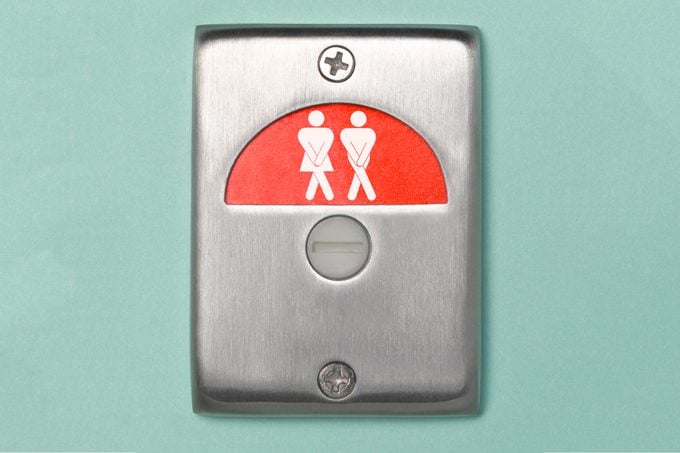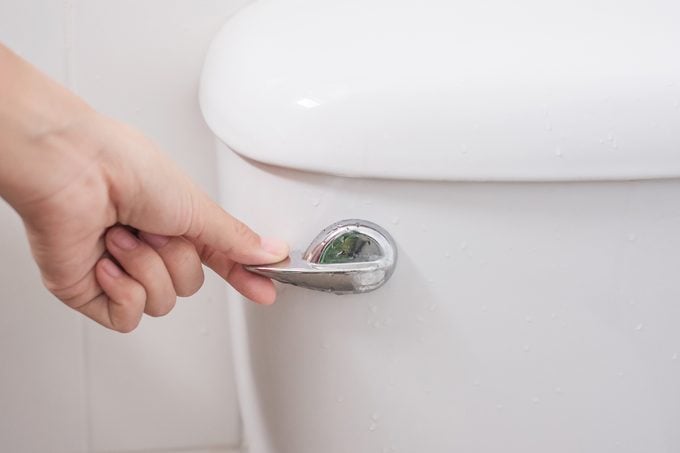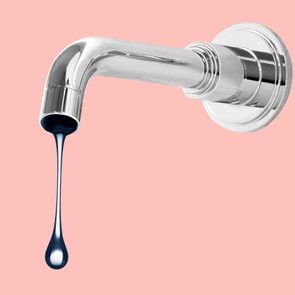14 Overactive Bladder Treatments Doctors Recommend
Updated: Mar. 30, 2022
If you frequently have the sudden urgent need to pee, you may have an overactive bladder. Here are the symptoms, causes, and treatments of this urinary condition.
Our editors and experts handpick every product we feature. We may earn a commission from your purchases.
What is overactive bladder?
While potty training is probably a distant childhood memory, the panicked feeling of “I need to pee right now and I don’t know if I can make it to the bathroom in time” is something many adults still experience.
If you get that feeling every once in a while—say after drinking a lot of coffee—it’s annoying but not abnormal. However, if you find yourself struggling with an urgent need to pee on a regular basis, especially when nothing has changed with your hydration habits, you may have an overactive bladder or OAB.
Overactive bladder isn’t a disease but rather a syndrome defined by a collection of symptoms, says Jennifer Linehan, MD, a urologist and associate professor of urologic oncology at the John Wayne Cancer Institute at Providence Saint John’s Health Center in Santa Monica, California.
The primary overactive bladder symptom is urinary urgency—the intense, sudden feeling that you need to pass urine. This feeling is caused by a breakdown in the communication signals from the brain to the bladder, causing the bladder muscle to spasm frequently and uncontrollably, she explains. The spasmodic contractions aren’t related to how much urine is actually in your bladder so you may feel the urge to pee constantly but typically little urine comes out each time.
OAB is often considered a women’s issue but it occurs in both genders, says S. Adam Ramin, MD, a Los Angeles-based urologist, medical director of Urology Cancer Specialists, and assistant professor of surgery at City of Hope National Medical Center. It affects up to 30 percent of men and 40 percent of women in the United States, according to the American Urological Association.
Exact numbers are difficult to pin down because people often don’t discuss symptoms like bladder leakage or needing to pee every hour, even with their doctors, he says. “There’s a lot of embarrassment around this issue,” he says. “Plus, many people think it’s just a normal part of aging so there’s no point in bringing it up. But while it is more common as people get older, it isn’t something you just have to accept.”

OAB symptoms
The main symptom of an overactive bladder is frequently feeling a sudden, urgent need to pee. Other common symptoms are urinary incontinence (an inability to hold your urine or urine leakage), urinary frequency (peeing more than once every hour or two), and nocturia (waking multiple times at night to pee).
You may also experience only being able to let out a small amount of urine, the inability to empty your bladder completely, or always feeling like you need to pee even after just using the toilet.
The causes of OAB
There are three main causes of OAB: age-related changes in the body, neurological conditions, and lifestyle factors. In about 30 percent of all cases, no known cause can be identified, Dr. Linehan says.
In aging men, OAB is most commonly due to an enlarged prostate gland pushing into the bladder, causing obstruction and inflammation, Dr. Ramin says.
An enlarged prostate gland happens as men age and is so common that it has been said all men will have an enlarged prostate if they live long enough. Prostate enlargement starts around 40 years old; by age 80 more than 90 percent of men have the condition. (These are the bladder health issues you need to watch for in every decade.)
In aging women, OAB is most often linked to hormonal changes that come with menopause, says Sherry A. Ross, MD, OB-GYN and women’s health expert in Santa Monica, California and author of She-ology: The Definitive Guide to Women’s Intimate Health. When estrogen decreases, it can cause the vagina and urethral lining to atrophy, she says, which makes them thin and less elastic. Because vaginal muscles support the bladder, changes to the vagina can affect the bladder, too.
In addition to those physical changes in the body, OAB can be caused by any neurological condition that disrupts the connection between the brain and the bladder, Dr. Linehan says. OAB is commonly found in patients with Alzheimer’s disease, Parkinson’s disease, and multiple sclerosis, she says.
Some lifestyle factors contribute to OAB, with the most common ones being those that lead to overweight or obesity, including a poor diet and lack of exercise, Dr. Ross says. Having a weak core or carrying extra pounds can increase pressure on the bladder, which can contribute to OAB, she says. Alcohol can also be a contributing factor.
Less common causes of OAB are anatomical defects from birth or injury, an illness like bladder cancer, or as a side effect of some cardiovascular medications, Dr. Ramin adds. If your bladder symptoms come on very suddenly and are accompanied by back pain or a feeling of increasing weakness or numbness in the legs, pelvis, and hips that may signal a medical emergency and you should seek medical attention immediately, he says.
How OAB is diagnosed
“Can you sit through an entire movie without needing to go to the bathroom?” Your answer to this one simple question is a quick-and-easy way to assess whether or not your urinary urgency has crossed the line into OAB, Dr. Linehan says.
“There isn’t a single diagnostic test that will tell you whether or not you have OAB, rather it’s about what your symptoms are and how much they are affecting your ability to live your life normally,” Dr. Ramin says.
The answers will vary from person to person so the best way to answer this for yourself is to keep a symptom journal that you share with your doctor, Dr. Linehan says. For 48 hours, write down: the time, amount, and type of every liquid you drink; every instance you urinate; the amount you are peeing out (your doctor can give you a “urine hat” to help you measure it); and how it affects your daily schedule. Reviewing your journal with your doctor can help you identify how serious your OAB is and what treatments you should try next, she says.
“We will run tests to rule out other issues that may be causing the symptoms, like dementia or an infection, so OAB is often a diagnosis of exclusion,” Dr. Linehan says. “It’s very common for urinary tract infections to mimic overactive bladder, in both women and men, so we will always test a sample of your urine.”
Your doctor may also order urodynamic tests. These tests are done in the office and offer more precise measurements, along with a look at how the bladder muscle and urinary sphincter are functioning. These can help diagnose whether there is a neurological cause of your OAB, Dr. Ramin says.

Home remedies for frequent urination
If you are experiencing OAB symptoms, it’s important to discuss them with your doctor as they can worsen over time and are easier to treat when caught early, Dr. Linehan says. However, there are things you can do at home to help manage your symptoms or in conjunction with a medical treatment program.
Kegels
These pelvic floor exercises are great for both men and women and can go a long way in helping reduce your OAB symptoms, Dr. Linehan says. “Many people with OAB have trained their bladder to have bad habits, Kegel exercises are a way of retraining that brain-body connection,” she explains. Any time you feel a sense of urgency, contract your pelvic floor muscles and hold for 10 seconds. Over time, this will reduce random bladder contractions. (Don’t do more than 30 per day however as you can exhaust those muscles and make the problem worse, she says.)
Core strengthening exercises
Your core and your pelvic floor are connected so strengthening your inner core and back muscles—think planks and Pilates exercises, not sit-ups—can help with bladder symptoms, Dr. Ross says. It’s worth paying for a visit or two with a pelvic floor therapist to teach you proper exercise technique, she adds. (Here’s how to take care of your pelvic floor.)
Timed voiding
Just like you teach a young child to train their bladder, so you can retrain your own bladder, Dr. Linehan says. “Put yourself on a schedule: Set a timer to use the bathroom every two or three hours and practice holding your urine between those times,” she says. “This will help train your bladder to get back into a more regular routine.”
Ban liquids at bedtime
Nighttime peeing is a common and very disruptive issue for many people with OAB. To reduce this, stop drinking liquids two to four hours before bedtime, Dr. Ramin says. (This isn’t an excuse to get dehydrated as that can lead to other health issues, so make sure you’re drinking plenty during the day.)
Nix caffeine
“Caffeine makes you pee more, both in amount and frequency, so eliminating or reducing caffeine intake can help a lot with OAB symptoms,” Dr. Ramin says. If you just can’t say goodbye to your coffee or soda, try to limit all caffeine consumption to the morning with no more after noon, he says. (Make sure you’re aware of these 8 hidden sources of caffeine.)
Consider pumpkin seed oil supplements
In a small study of 45 people, pumpkin seed oil reduced symptoms of overactive bladder, according to a report published in the Journal of Traditional and Complementary Medicine. “This isn’t as effective as prescription medications but for my patients who prefer to try natural treatments first, this is a good option and it does provide some benefit,” Dr. Linehan says. A typical dose is one to three 1,000 mg capsules per day.
Wear absorbent underwear
Wearing adult incontinence underwear or pads can help restore your confidence and increase your ability to do extended activities, like shopping, without worrying about leaks or accidents. These products are much more comfortable and discreet than they used to be, says Dr. Ross, so there’s no reason to be embarrassed. (One incontinence underwear brand is Speax by Thinx.)
Medications and other treatments for overactive bladder
People are often hesitant to try medication or other medical treatments for overactive bladder because they’re worried about side effects or they feel like this is just something they have to live with as they age. This is a mistake, Dr. Ramin says.
“There’s a lot we can do to not just manage your symptoms but also treat the underlying problems,” he says. “You do not need to tolerate bladder problems and they do not need to be ‘just a part of getting older’.”
OAB medications
The front-line treatment for overactive bladder are medications, either daily pills or taken as a preventative before specific occasions Dr. Linehan says. There are two main types: beta agonists and anticholinergics.
“These medications calm your bladder, giving it more time to fill between urinations,” she says. Each of these have different side effects and interactions with other drugs so talk to your doctor about which one will work best for your situation. Medications include:
- Darifenacin (Enablex)
- Fesoterodine (Toviaz)
- Mirabegron (Myrbetriq)
- Oxybutynin
- Tolterodine (Detrol)
- Trospium (Sanctura)
Botox injections
In cases where the bladder is spasming uncontrollably, Botox injections can help calm that muscle, Dr. Linehan says. (Here are 10 things you should know about botox injections.)
Nerve stimulation
For severe cases of OAB, you can get a “bladder pacemaker” implanted, Dr. Linehan says. This involves implanting an electrical device into either your tibial nerve in your ankle or your sacral nerve in your back. Via an app on your phone, you can use the electrodes to calm and regulate the nerves that go to your bladder, she explains. This requires a short surgical procedure.
Urinary retention medications
For men, using tamsulosin (Flomax) can help reduce the symptoms of OAB from an enlarged prostate at the same time, Dr. Ramin says. This medication can be used alone or in conjunction with other OAB medications.
Hormone pills or creams
For women, overactive bladder is often linked with hormonal changes so treating hormone imbalances, usually with estrogen pills or creams, may help reduce bladder problems, Dr. Ross says. (Worried about taking hormones? Here’s what doctors need you to know about HRT and breast cancer.)
Surgery
There is no surgery for simply having an overactive bladder. However, if there is an underlying structural or anatomical issue—like a vaginal prolapse that is putting pressure on your bladder— your doctor may recommend a corrective surgery, Dr. Linehan says.

















